![]()
![]()
![]()
Use LEFT and RIGHT arrow keys to navigate between flashcards;
Use UP and DOWN arrow keys to flip the card;
H to show hint;
A reads text to speech;
26 Cards in this Set
- Front
- Back
|
What are the big picture PK considerations in renal failure?
|
*Oral Bioavailability can be altered with Nausea, vomiting, diarrhea; these cause changes in GI motility and pH.
*Vd can be altered with: -Alterations in fluid balance, protein binding. -Decrease in protein binding of acid drugs. -Competition of binding with accumulated drug metabolites, free fatty acids, urea. *Clearance can be altered with decreased glomerular filtration, tubular secretion, or intrinsic hepatic clearance. |
|
|
What are the Assumptions of Dose Adjustment Methods in Renal Disease? 6
|
1) Effective plasma concentration is unchanged.
2) Nonrenal (i.e. hepatic) clearance of drug is unchanged. This might not actually be true! But, it's too hard to figure this in, so we assume it is unchanged. 3) Protein binding of drug is unchanged. 4) Volume of distribution is unchanged. 5) GI absorption of drug is unchanged. *The one thing we assume to be changed is the kidney's ability to handle the drug (decreased GFR). |
|
|
In patients with renal failure, what is their clearance like compared to normal? What is drug half life like compared to normal?
|

|
|
|
What's the big picture goal in renal adjustment?
What 3 specific strategies can we employ? |
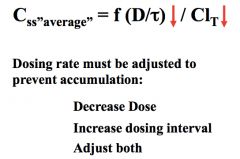
*GOAL: PREVENT DRUG ACCUMULATION!
|
|
|
How much should we decrease the loading dose for a patient with kidney failure?
|

*TRICK!
*Loading Dose is usually the same because we assume NO CHANGE in Vd, and loading dose is calculated based on Vd. *MAINTENANCE DOSES, however, are lowered. |
|
|
What are the two most important questions to ask when you are trying to determine if it is appropriate to modify a dosage regimen in renal disease?
|
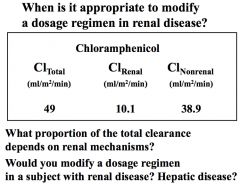
1) How much of this drug is excreted by the kidneys?
2) How is my patient's kidney function compared to normal? *In the example of chloramphenicol, renal clearance is only about 20% of the drug's clearance. You probably would NOT have to modify dosing. |
|
|
What are GFRs in the 5 stages of CKD?
|
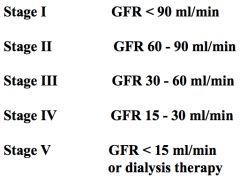
|
|
|
How do we calculate Dose Adjustment Based on Drug Clearance?
WHAT'S THE EQUATION I NEED TO KNOW? |
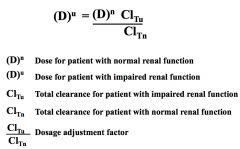
|
|

*This is PK information on PenG. What can we infer about the way the kidneys handle this drug from this information?
|

1) Renal clearance is IMPORTANT (630/700).
2) The drug is being filtered and there's some ACTIVE TRANSPORT (secretion?) going on (since clearance is way over normal GFR of 120). 3) The drug is stored in more than just the IV space, since Vd is 42% of body weight! It is lipophilic and even goes beyond ECF; it is inside of cells, too. |
|
|
The effective plasma concentration for a disease-causing bacteria, such as streptococci, at which there is evidence of sensitivity to penicillin G is 0.1 mg/ml.
What infusion rate (ko) of penicillin G would you recommend to achieve this effective steady-state plasma concentration? |

*Steady state concentration = infusion rate over total clearance.
|
|
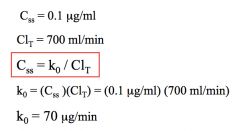
What loading dose might you recommend by bolus IV injection to rapidly achieve the effective plasma concentration level of 0.1µg/mL?
Would this loading dose alter the level achieved at steady-state by the continuous infusion? |

*The loading dose is about 3mg! This does NOT change the level achieved by continuous infusion.
|
|
|
A patient with severe renal impairment has a reduction of total clearance to 350 ml/min (normally 700).
What infusion rate (IF NO LOADING DOSE) would you recommend to achieve an effective steady-state plasma concentration of 0.1µg/mL? |
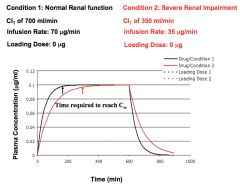
*If you DIDN'T change your infusion rate, the plasma steady state concentration would be TWICE as high, since the clearance is HALF.
*NOTE that with impaired clearance it takes longer to reach steady state. |
|
|
In renal impairment, would you change your recommendation for a loading dose by bolus IV injection?
|
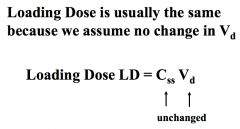
*NO! IT DOES NOT CHANGE!!!!!!!!!
|
|
|
How does IV infusion and drug excretion differ with a renally excreted drug in someone with normal GFR and someone with renal impairment?
|
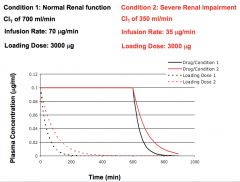
*Same loading dose, lower infusion rate.
*Note that if the IV drip is turned off, it takes longer in impairment for the drug to be excreted. |
|
|
So how do we estimate our patient's ability to excrete drugs renally? What substance do we look at? Why?
|
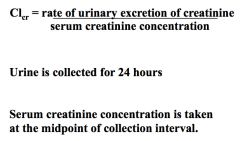
*Creatinine.
*Endogenous substance formed from muscle metabolism. *Cleared by kidney by filtration and some active transport (secretion). *Production varies with age weight and sex. *NOTE equation for creatinine clearance. We don't actually use this equation...ever...because it's hard to get an accurate 24 hour urine sample. |
|
|
In real life, how do we calculate creatinine clearance?
What's the equation? |

*We use serum creatinine level.
*Creatinine production = creatinine clearance. *Serum creatinine levels are constant. *Elevated serum creatinine means the patient is not excreting it like he should. |
|
|
What is a nomagram? What are they based on?
|
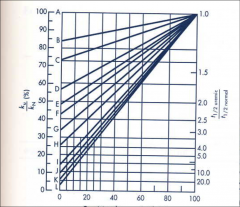
Nomagrams are charts based on:
1) Serum creatinine concentration. 2) Patient data (height, weight, age, gender). 3) PK of drug (how much is renally cleared). |
|
|
What are the assumptions a nomagram makes?
|
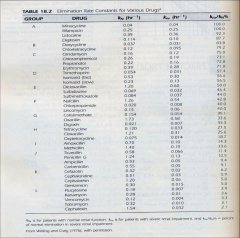
1) Nonrenal clearance is not affected by renal disease.
2) Uremic elimination rate constant is proportional to the product of a constant and the creatinine clearance. |
|
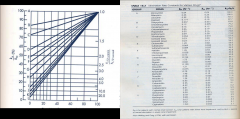
*500 mg of Lincomycin is given every 6 hr to a 75 kg normal patient.
*What dose should be used for patient with CLcr = 10ml/min? |

|
|
|
What is the advantage of the Giusti-Hayton Method?
What assumption does it make? |
*Giusti-Hayton Method is useful when the fraction
of drug excreted (fe) in the urine is known ("Fraction of Drug Excreted Unchanged"). *Assumption: the effect of reduced kidney function on the renal portion of the elimination rate constant is related to the ratio of impaired creatinine clearance to normal creatinine clearance. |
|
|
What is the equation used in the Giusti-Hayton Method if you're looking to ADJUST DOSE IN RENAL DISEASE?
|
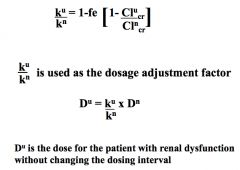
|
|
|
What is the equation used in the Giusti-Hayton Method if you're looking to EXTEND THE DOSING INTERVAL IN RENAL DISEASE?
|

|
|
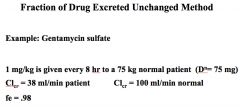
What dose do you give to this renally impaired patient?
|
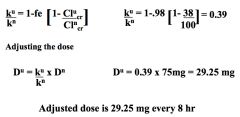
|
|
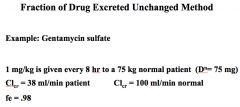
What would you increase the dosing interval to in this renally impaired patient?
|

|
|
|
What is the General Clearance Method for calculating adjusted doses in renal disease?
What's the equation? |

|
|
|
How does the General Clearance Method for calculating adjusted doses in renal disease work?
What is a disadvantage? |
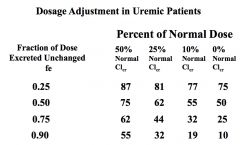
*Uses tables based on fe and degree of renal impairment.
*Not as accurate as other methods. |

